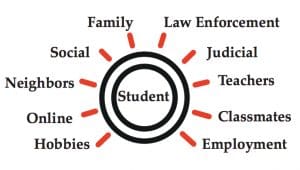The Secret Service’s newly-released report on creating programs for conducting a threat assessment in schools provides a guide for officials to compare to their own systems.
The report was released by the agency’s National Threat Assessment Center, which was created in 1998 to provide guidance and training on threat assessments to criminal justice and public safety professionals.
Threat assessment programs should be one part of a larger campus protection system. Still, when done right, threat assessments can be an extremely powerful tool to protect your campus because, despite popular opinion, there is no reliable profile of student attackers.
“Rather than focusing solely on a student’s personality traits or school performance, we can learn much more about a student’s risk for violence by working through the threat assessment process, which is designed to gather the most relevant information about the student’s communications and behaviors, the negative or stressful events the student has experienced, and the resources the student possesses to overcome those setbacks and challenges,” the authors state.
The report should be interpreted as “minimum guidelines” for school officials to adjust to their own unique campus situations.
Below we summarize the information in the report for readers to compare to their own threat assessment process in schools.
Step 1: Establish A Multidisciplinary Threat Assessment Team in Your School
The threat assessment team will receive reports about concerning students and situations, gather additional information, assess the risk posed to the school community and develop intervention and management strategies to mitigate risk.
Threat assessment teams should have a specifically designated leader and include personnel from a variety of disciplines including teachers, guidance counselors, coaches, school resource officers, mental health professionals and school administrators.
Teams should establish procedures that account for the following:
- Who will interview students of concern
- Who will talk to classmates, teachers, or parents
- Who will be responsible for documenting the team’s efforts
Step 2: Define Prohibited and Concerning Behavior in School
Schools need to define prohibited behaviors that are unacceptable and warrant immediate intervention. Policies should also identify behaviors that may not be indicative of violence but also warrant some type of intervention and support, such as:
- A marked decline in performance
- Increased absenteeism
- Withdrawal or isolation
- Sudden or dramatic changes in behavior or appearance
- Drug or alcohol use
- Erratic, depressive, and other emotional or mental health symptoms
The threshold for intervention should be relatively low so that teams can identify students in distress before their behavior escalates to the point that classmates, teachers, or parents are concerned about their safety.

In a study of 51 averted acts of school violence, the plot was discovered in 17 incidents when the perpetrator directly told somebody about their violent plans/threats and in 10 incidents when they mentioned their violent plans on social media.
Step 3: Create A Central Reporting Mechanism
Schools may establish one or more reporting mechanisms that are accessible for their community (there should be an option to pass information along anonymously). Students, teachers, staff, school resource officers and parents should be trained on recognizing behaviors of concern; their roles and responsibilities in reporting the behavior; and how to report the information.
A team member should proactively monitor all incoming reports and respond immediately when someone is concerned about the safety of themselves or others.
The school community should feel confident that team members will be responsive to their concerns and that reports will be acted upon, kept confidential, and handled appropriately.
Step 4: Determine The Threshold for Law Enforcement Intervention in School
It’s likely that the vast majority of incidents can be handled by school personnel, but reports regarding student behavior involving weapons, threats of violence, physical violence, or concerns about an individual’s safety should immediately be reported to local law enforcement.
If a school resource officer is not available to serve on the threat assessment team, schools should set a clear threshold for times and situations when law enforcement will be asked to support or take over an assessment.
Step 5: Establish Threat Assessment Procedures
Clearly defined procedures should guide each threat assessment so that your team forms an accurate picture of the student’s thinking, behavior and circumstances. Some things to keep in mind during this process include:
- Safety concerns should be immediately addressed before beginning these procedures.
- Maintain documentation of everything. Documentation forms and templates should be included in the plan to ensure standardization.
- Use a community systems approach to gathering information by identifying the sources that may have information on the student’s actions and circumstances. This includes people, organizations and platforms.
- Examine online social media pages, conduct interviews, review class assignments and consider searching the student’s locker or desk. Team members should also review academic, disciplinary, law enforcement and other formal records related to the student.
- Build rapport that can facilitate information gathering efforts
- Evaluate the student’s concerning behaviors and communications in the context of his/her age and social and emotional development.

Source: National Threat Assessment Center. (2018). Enhancing school safety using a treat assessment model: An operational guide for preventing targeted school violence. U.S. Secret Service, Department of Homeland Security
Threat assessment teams should also organize their information around themes pertaining to the student’s actions, circumstances and other relevant factors. Each theme should be addressed and used to identify the most appropriate resources for the student. Themes to explore include:
- Motives
- Concerning, unusual or threatening communications
- Inappropriate interests in concerning topics
- Weapons access
- Stressors such as setbacks, losses and other challenges
- Emotional and developmental issues (behaviors of a student with a diagnosed disorder need to be evaluated in the context of that diagnosis)
- Desperation or despair
- Violence as an option
- Behaviors that may have elicited safety concerns from others
- Capacity to carry out an attack
- Planning (student plans do not need to be elaborate)
- Consistency of statements with behaviors
- Protective factors that could restore hope to a student, including a trusting relationship with an adult or emotional connections to other students
Step 6: Develop Risk Management Options
After evaluating whether a student is at risk of violence, an individualized management plan can be developed to reduce the student’s risk for engaging in violence and make positive outcomes more likely.
Threat assessment teams will often determine a student is not currently at risk for engaging in violence but requires monitoring, guidance, or resources such as peer support programs, counseling, life skills classes, tutoring or mental health care (teams may need to partner with the community for some of these resources).
If risk management involves suspension or expulsion, teams should consider how it might affect their ability to monitor the student. Removing a student from a school does not eliminate the risk to the school community.
Management plans should remain in place until the threat assessment team is no longer concerned about the student or the risk for violence. This is accomplished by addressing the following elements that reduce the risk of violence:
- Notify law enforcement immediately if a student is thinking about engaging in violence
- Make efforts to address the safety of any potential targets
- Create a situation that is less prone to violence
- Remove or redirect the student’s motive
- Reduce the effects of stressors
Step 7: Create and Promote Safe School Climates

Of 51 instances of averted school violence studied by the Police Foundation, a student peer initially discovered the attack plan in 29 incidents.
A crucial component of preventing targeted school violence relies on developing positive school climates built on a culture of safety, respect, trust and social/emotional support.
Staff members should support diversity, encourage communication, intervene in conflicts and work to prevent bullying and teasing. Students should feel empowered to share concerns with adults.
Students also have a role to play in sustaining safe schools. They should be actively engaged in their schools, encouraged to reach out to classmates who might be lonely or isolated and empowered to intervene safely when they witness gossiping, teasing and bullying.
Step 8: Conduct Training For All Stakeholders
Finally, identify training needs for every stakeholder who could come forward with concerning information or who might be involved in the threat assessment process in schools. Different audiences will require a slightly different message, but effective training should always address the goals and steps of an assessment, the type of information that should be brought forward and how to report concerns.
Student training may be especially unique from other audience trainings. Schools may choose to include parents in student training sessions, and students need to be assured they can make a report anonymously, their information will be followed up on and that it will be kept confidential.
Messaging should also explain the difference between “snitching” and seeking help. Snitching is informing on someone for personal gain, while coming forward with concerns about a friend is a way to help that person and prevent them from getting hurt.
Final Thoughts on The School Threat Assessment Guide
The Secret Service’s 2002 report on threat assessments proved to be a valuable tool for the campus security industry, and with this new report, the Secret Service hopes to further guide officials toward establishing a threat assessment in schools.
Still, the agency warns that comprehensive violence prevention plans will not ensure violence does not occur at your school. That’s why emergency response plans are also essential.
But threat assessments are an important component of school officials’ efforts to keep their campuses safe. We’re hopeful that this guide can aid those efforts.
Citation: National Threat Assessment Center. (2018). Enhancing school safety using a treat assessment model: An operational guide for preventing targeted school violence. U.S. Secret Service, Department of Homeland Security







